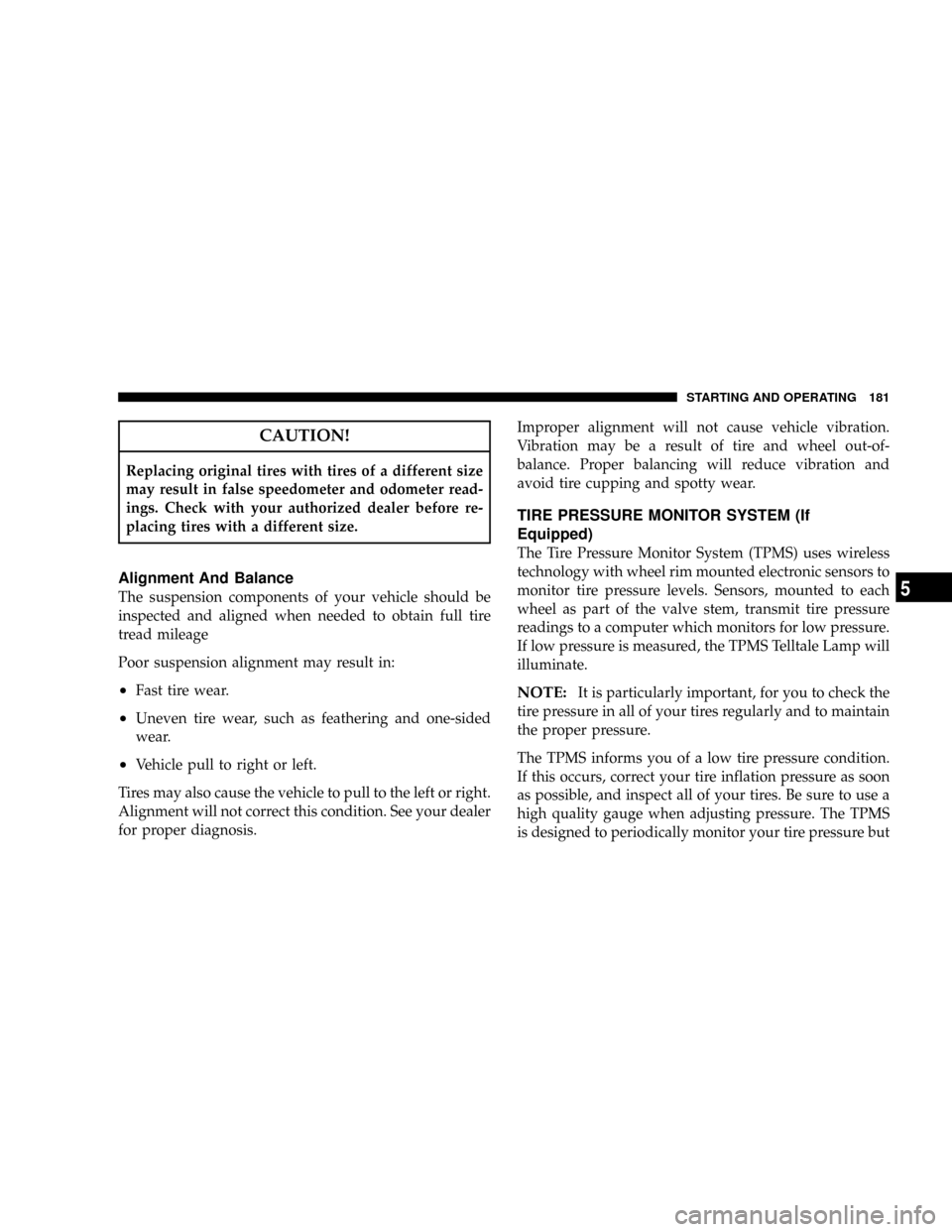suspension CHRYSLER CROSSFIRE 2007 1.G Owners Manual
[x] Cancel search | Manufacturer: CHRYSLER, Model Year: 2007, Model line: CROSSFIRE, Model: CHRYSLER CROSSFIRE 2007 1.GPages: 299, PDF Size: 8.26 MB
Page 180 of 299

Recommended Tire Inflation Pressures
Sport Performance (Y speed rating) tires and All-Season
Performance (W speed rating) tires
Front 225/40 ZR18............... 32psi(221 kPa)
Rear 255/35 ZR19................ 33psi(227 kPa)
Sport Performance (Y speed rating) tires and All-Season
Performance (W speed rating) tires above 100 mph (161
km/h)
Front 225/40 ZR18............... 36psi(248 kPa)
Rear 255/35 ZR19................ 36psi(248 kPa)
Winter tires
Front 225/40 VR18 M+S........... 33psi(227 kPa)
Rear 225/40 VR18 M+S............ 36psi(248 kPa)WARNING!
²When obtaining replacement tires, assure that the
tires are specified for replacement on the Crossfire.
Tires with the same size, speed, or load ratings that
are specified for replacement on other vehicles may
not properly fit on the original equipment wheels of
your vehicle.
²Do not use a tire, wheel size or rating other than that
specified for your vehicle. Some combinations of
unapproved tires and wheels may change suspension
dimensions and performance characteristics, result-
ing in changes to steering, handling, and braking of
your vehicle. This can cause unpredictable handling
and stress to steering and suspension components.
You could lose control and have an accident resulting
in serious injury or death. Use only the tire and wheel
sizes with load ratings approved for your vehicle.
²Never use a tire with a smaller load index or capacity,
other than what was originally equipped on your
vehicle. Using a tire with a smaller load index could
result in tire overloading and failure. You could lose
control and have an accident.
²Failure to equip your vehicle with tires having ad-
equate speed capability can result in sudden tire
failure and loss of vehicle control.
180 STARTING AND OPERATING
Page 181 of 299

CAUTION!
Replacing original tires with tires of a different size
may result in false speedometer and odometer read-
ings. Check with your authorized dealer before re-
placing tires with a different size.
Alignment And Balance
The suspension components of your vehicle should be
inspected and aligned when needed to obtain full tire
tread mileage
Poor suspension alignment may result in:
²Fast tire wear.
²Uneven tire wear, such as feathering and one-sided
wear.
²Vehicle pull to right or left.
Tires may also cause the vehicle to pull to the left or right.
Alignment will not correct this condition. See your dealer
for proper diagnosis.Improper alignment will not cause vehicle vibration.
Vibration may be a result of tire and wheel out-of-
balance. Proper balancing will reduce vibration and
avoid tire cupping and spotty wear.
TIRE PRESSURE MONITOR SYSTEM (If
Equipped)
The Tire Pressure Monitor System (TPMS) uses wireless
technology with wheel rim mounted electronic sensors to
monitor tire pressure levels. Sensors, mounted to each
wheel as part of the valve stem, transmit tire pressure
readings to a computer which monitors for low pressure.
If low pressure is measured, the TPMS Telltale Lamp will
illuminate.
NOTE:It is particularly important, for you to check the
tire pressure in all of your tires regularly and to maintain
the proper pressure.
The TPMS informs you of a low tire pressure condition.
If this occurs, correct your tire inflation pressure as soon
as possible, and inspect all of your tires. Be sure to use a
high quality gauge when adjusting pressure. The TPMS
is designed to periodically monitor your tire pressure but
STARTING AND OPERATING 181
5
Page 234 of 299

Before removing the reservoir cap, wipe the outside of
the cap and reservoir so that no dirt can fall into the
reservoir.
The power steering pump has a dipstick. Fluid level
should be maintained at the proper level indicated on the
dipstick. If the indicated level of power steering fluid is
low, see your authorized dealer. With a clean cloth, wipe
any spilled fluid from all surfaces.Chassis Lubrication
Front Suspension Ball Joints
There are two front suspension lower ball joints that are
permanently lubricated. Inspect these ball joints when-
ever under-vehicle service is done.
Steering Linkage
Inspect tie rod ends whenever the vehicle is serviced.
They are permanently lubricated and do not require
periodic lubrication.
Drive Shaft Universal Joints
Your vehicle has four constant velocity universal joints.
Periodic lubrication of these joints is not required. How-
ever, the joint boots should be inspected for external
leakage or damage when other maintenance is per-
formed.
If leakage or damage is evident, replace the universal
joint boot and grease immediately.
Continued operation could result in failure of the univer-
sal joint due to water and dirt contamination of the
grease. This would require complete replacement of the
joint assembly.
234 MAINTAINING YOUR VEHICLE